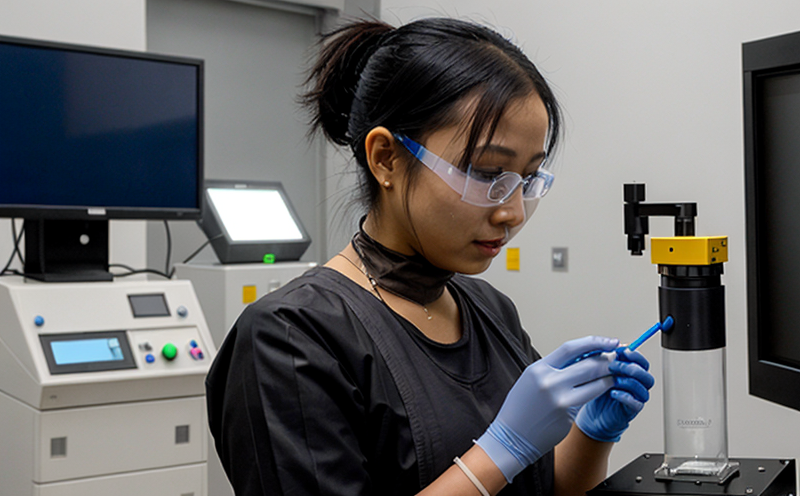ISO 25101 Testing of Nanomaterials in Groundwater by Adsorption Methods
The ISO 25101 standard provides a robust framework for the testing and evaluation of nanomaterials in groundwater. This method is particularly important as it ensures that any potential environmental impact from these materials can be accurately assessed before they enter the broader ecosystem.
Understanding the behavior of nanomaterials in groundwater is crucial because nanoparticles have unique properties that differ significantly from their bulk counterparts. These properties can affect how particles interact with biological and chemical systems, making accurate testing imperative for compliance and safety. The adsorption method used in ISO 25101 helps to simulate real-world conditions where nanomaterials are likely to be found.
The process involves preparing a sample of groundwater that is known or suspected to contain the nanomaterials under study. This sample is then allowed to come into contact with adsorbent materials, which capture and concentrate the nanomaterials present in the water. The concentration factor allows for more accurate detection of low concentrations of nanomaterials.
Post-adsorption, the samples are analyzed using advanced analytical techniques such as Transmission Electron Microscopy (TEM), Scanning Electron Microscopy with Energy Dispersive Spectroscopy (SEM-EDS), and X-ray Diffraction (XRD). These methods provide detailed information about the physical properties of the nanomaterials, including size distribution, morphology, and elemental composition. This data is crucial for understanding how these materials might behave in different environmental conditions.
The adsorption method also helps to identify potential risks associated with the release of nanomaterials into groundwater. By quantifying the amount of nanoparticles that can be adsorbed onto natural surfaces within the aquifer, we gain insights into their mobility and persistence under various hydrogeological settings. This information is vital for environmental risk assessment and management strategies.
The ISO 25101 method ensures consistency across different laboratories by providing standardized procedures for sample preparation, analysis, and interpretation of results. Compliance with this standard helps to build confidence in the reliability of test data, which is essential for regulatory compliance and informed decision-making.
Key benefits of using ISO 25101 include:
- Enhanced accuracy in detecting nanomaterials at low concentrations
- Inclusion of real-world simulation through adsorption processes
- Standardized methods ensuring consistent and reliable results
- Support for regulatory compliance with international standards
- Possibility to assess potential environmental risks accurately
The process also facilitates the development of effective mitigation strategies by providing detailed information on nanomaterial behavior.
Benefits
Enhanced accuracy in detecting nanomaterials at low concentrations
Inclusion of real-world simulation through adsorption processes
Standardized methods ensuring consistent and reliable results
Support for regulatory compliance with international standards
Possibility to assess potential environmental risks accurately
Facilitation of effective mitigation strategies through detailed information on nanomaterial behavior.
The ISO 25101 testing method is invaluable for ensuring that nanomaterials are safe and do not pose a risk to the environment. It provides a comprehensive approach to understanding how these materials interact with groundwater, enabling stakeholders to make informed decisions about their use and disposal.
Industry Applications
Environmental Impact Assessment (EIA) for projects involving the discharge of nanomaterials into groundwater
R&D in the field of nanotechnology, particularly when assessing the environmental behavior and impact of new materials
Regulatory compliance for industries that handle or produce nanomaterials, ensuring adherence to international standards
Development of safer products by identifying potential risks associated with the use of nanomaterials in consumer goods
Sustainable management of water resources by monitoring and mitigating the presence of nanomaterials in groundwater
Evaluation of remediation strategies for contaminated sites, where nanomaterials may be present or could be used as part of a cleanup plan.
ISO 25101 testing is widely recognized and accepted by regulatory bodies worldwide. It has been adopted in various countries including the United States, Europe, Canada, and Asia. Compliance with this standard is crucial for industries dealing with nanomaterials to ensure that their operations are both safe and environmentally responsible.
International Acceptance and Recognition
The ISO 25101 method has gained widespread acceptance in the scientific community, regulatory agencies, and industry. Its adoption is driven by its robust methodology and ability to provide accurate data on nanomaterial behavior in groundwater.
Regulatory bodies such as the Environmental Protection Agency (EPA) in the United States, Environment Canada, and various European Union directives recognize ISO 25101 as a key standard for assessing environmental risks associated with nanomaterials. This recognition ensures that testing conducted according to this method is widely accepted across borders.
The method's international acceptance also extends to academic research where it serves as the benchmark for evaluating new technologies and materials. Researchers worldwide use ISO 25101 to ensure their findings are consistent and comparable, contributing to a global understanding of nanomaterial behavior in groundwater.
By adhering to this standard, organizations can demonstrate their commitment to environmental stewardship and regulatory compliance. This not only reduces legal risks but also enhances brand reputation by showcasing responsible practices.





